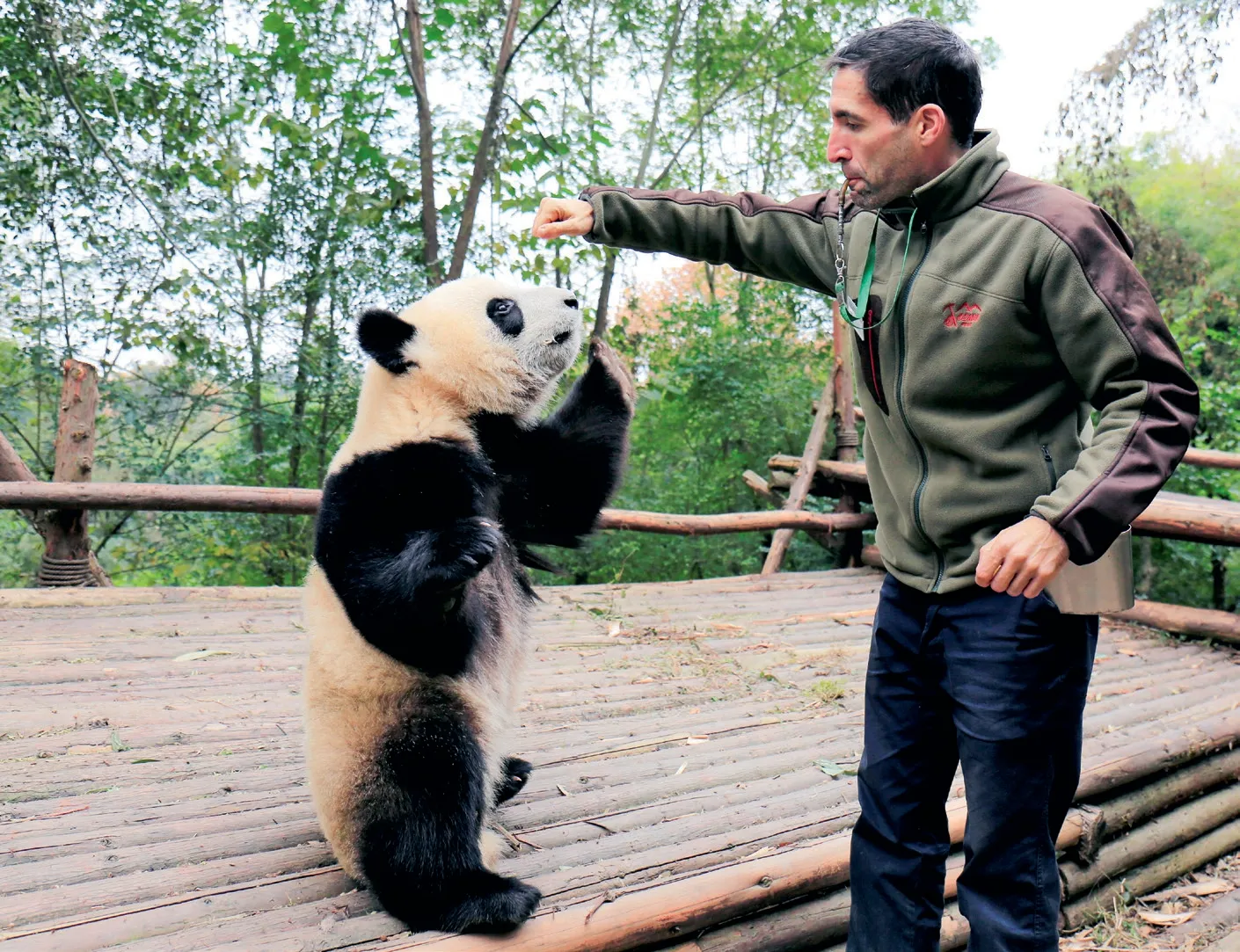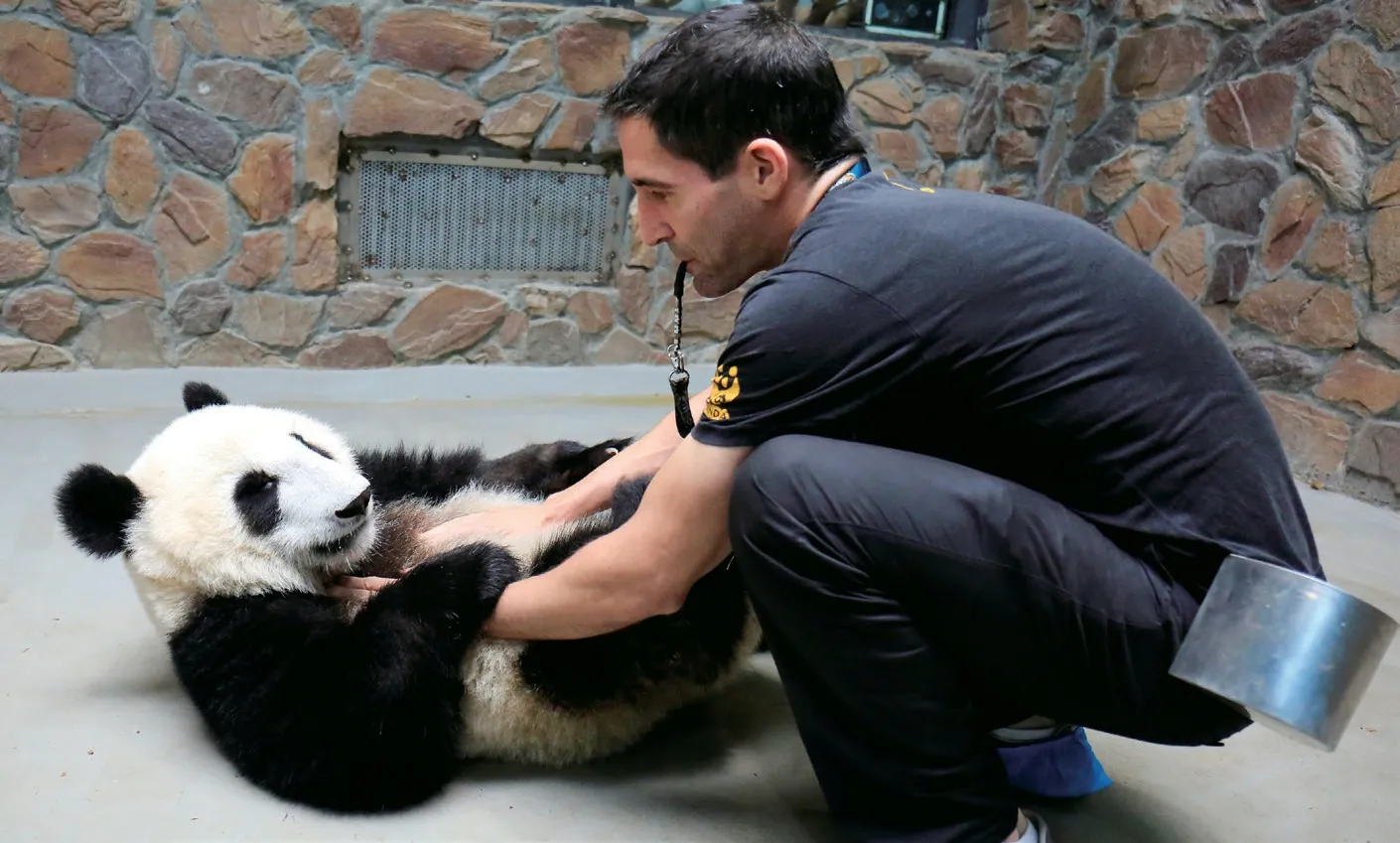在成都大熊猫基地爱上中国
今年是虎年,这个生肖年对我来说意义非凡。我第一次来中国是在2010年,上一个虎年,这意味着我在这个美好的国家——现在被我称为“家”,已经度过了一整轮生肖周期。无论出于个人角度还是职业角度,这个虎年汇集了我生命中的几个重要事件。2022年,我的大哥Dave就年满50周岁了。这让我难以相信。近半个世纪以来,我一直在“仰视”他,如果没有他的爱和支持,我不会在国外生活这么久。2022年,我也分别迎来我侄子Lucas和Logan的20岁和17岁生日。我第一次来中国时,他们还只是小孩子,而现在他们已经长大成人。毫无疑问,我留在中国这么久的最大遗憾是我错过了他们太多的童年时光。于我而言,家人意味着一切,离开家人是一个严峻的挑战。从专业角度来说,2022年意味着我与野生动物打交道的职业生涯走过了25年。不妨说这是我的“丝绸之路”,让我走上了通往中国的道路。
25年前的1997年,我开始在纽约的科尼岛水族馆做志愿者。我在学生时代的生物课成绩就很好,一直以来我对动物都很感兴趣。大学毕业后,我决定要做一名动物园管理员。成为志愿者的第二天,是我永远难忘的一天。除了在新工作之初,我因一无所知而产生典型焦虑感之外,强烈的、无处不在的鱼腥味差点让我提前结束职业生涯。那天清晨,我刚刚称出并分离了大约50公斤的生鱼,为每只动物准备了特别的餐食,并清洗了数不清的盘子,这时我突然被叫去帮着喂海象。显然,水族馆那天人手不足。无论如何,没有什么能让我对接下来发生的事真正地提前做好准备。动物园管理员递给我一桶鱼,说:“你来喂Aiviq,不要夸‘好’,那是我们训练时才使用的专用词。慢慢来,跟着我走,跟上我,如果它从水里出来了,就赶紧跑向应急梯。”在这样的指引下,我穿过一扇厚重的钢板门,耐心等待着——在我面前的水里的,就是Aiviq。
Aiviq重达1000公斤,是一只年轻的雄性海象。当我盯着它巨大的头颅时,我的脑海中浮现出它杀死我易如反掌的各种画面。拜丰富的想象力所赐,我当即想到它在我身上自在翻滚的样子,甚至能用它巨大的体重压死我,或者把我撞到水里淹死我,或者让我在接近冰点的水中渐渐冻死。当我“沉浸”在这些可怕的死法中时,Aiviq大声呼了一口气,我猛然清醒过来。看着它满眼期待地盯着我,我突然反应过来:哦,是的,我该喂它了。当我伸手喂鱼给它吃时,我拂过它那又长又粗的触须,就像硬塑料吸管一样,向着它嘴的方向蠕动着。随着嘴唇最轻微、最温柔的接触,它啜饮起鱼来。我很难用言语来形容当时的感受,但好像有些微妙的变化正在悄悄发生着。这种感觉如雨后初霁。那一刻,我向自己承诺:无论如何,我都要致力于动物保护。
时间快进到15年后的2012年,我兑现了我的承诺。在美国当过动物园管理员后,我回到大学继续攻读保护生物学硕士学位,成为波多黎各一家灵长类动物中心的经理,之后又在中国的一家黑熊康复中心工作了一年半。后来,我经历了另一件改变了我人生轨迹的事,而这与另一种动物相关。这一次,我在成都大熊猫繁育研究基地工作。我带着一碗切好的苹果,与一只名叫“美兰”(音译)的成年雄性熊猫面对面地进行了一次正强化训练(我会在下文解释其含义)。
时间再次慢了下来,就像电影《黑客帝国》中的一个场景那样。我可以看到美兰每一根长睫毛,甚至能给它湿润的大鼻子来次特写。令我想不到的是110公斤的美兰竟可以不费吹灰之力地把我的胳膊掰成两半。它可以轻易地咬掉我的手指,甚至直到我尖叫之前,它自己不会有察觉。我工作时和很多熊打过交道,但从来没有一次像现在这样和大熊猫亲密接触过。虽然很多人会痴迷于大熊猫看起来有多么可爱,但与它们打交道的专业人士却对其强大力量充满敬意。于是,有关我被打伤或打死的各种场景又一次在我脑海中慢慢展开。不过这一次,我的同事袁波(音译)清了清嗓子。我回过神来:哦,是的,我应该去喂熊猫。我慢慢递出一片苹果,美兰轻轻叼走,自信而温柔,完全不像我想象的那样。微妙的变化又发生了,一切都恰到好处。
《一切都恰到好处》(Everything in its right place)是英国摇滚乐队Radiohead的一首歌,这首歌完美概括了我这十年在成都大熊猫基地的工作感受。当第一次来到大熊猫基地时,我立即明白了基地需要什么,毕竟这写在我的岗位描述里了。我的工作是为熊猫的正强化训练和环境丰富化提供建议和帮助,不断寻求改善熊猫健康和福祉的方法。此外,我将成为一名行为研究员。虽然这是基地所需要的,也是我梦寐以求的工作,但其实我真正在意的是一种归属感。
对我来说,离家那么久,我不仅需要一份令我满足的工作,更需要一个好家庭。尽管我很热爱我的工作,并从中找到了个人价值,但最终是同事们的热情、同情和友谊超越了语言障碍和文化障碍,支撑我一直在大熊猫基地工作下去。在我上班的第一天,当时的研究主任侯荣(音译)见到我,并给了我一个“全权委托”。她告诉我,她会支持任何能够改善熊猫福祉和管理的工作,她也是这么做的。从一开始,侯主任和同事们的支持对我来说意味着一切。
在最初几个月,我沉浸在与大熊猫有关的一切中。它们是如此独特又惊人的物种。有关大熊猫的解剖学、生理学和行为学的几乎每个方面都围绕着一个简单的事实,即从一种食肉的杂食熊进化成了一种专吃竹子的觅食者。不夸张地说,大熊猫99%的食物都是竹子。在它们可爱的圆滚滚的脑袋、和小泰迪熊一样的口鼻中,有着高度进化的锚点,这些锚点正是它们巨大而极其强大的下颚肌肉所需要的,用以折断、压碎和咀嚼竹子。它们可爱的像连指手套一样的爪子之所以会长成这样,是因为它们的假拇指进化到可以帮助它们抓住和操纵竹子。它们懒惰、自在地大摇大摆,实际上是新陈代谢低于预期的结果——这也是一种适应方式,帮助它们应对因竹子饮食造成的营养缺乏的问题。这些只是大熊猫进化到以竹子为食时众多适应方式中的三种,更深入的细节已经超出了这篇文章应提及的内容。但请相信我,理解大熊猫与竹子之间的独特关系是保护大熊猫、成功管理圈养物种的基础。
那么,如何成功管理圈养的大熊猫呢?这个问题很复杂。有两种动物饲养实践已被证明是至关重要的,这就是正强化训练和环境丰富化。正强化训练(或简称“训练”)是一种训练动物的技术,即每次动物正确执行指令时奖励它们食物。这种训练提高了动物对指令的响应效率。作为筹备动物公演过程中的一环,这种训练方法在动物园和水族馆已经有几十年的使用历史了。而最近,动物管理员开始通过训练以让动物配合兽医检查。这种实践对管理圈养熊猫而言至关重要,让我们能够在不为它们注射麻醉剂的情况下收集血样、注射疫苗并进行体检。此举大大减轻了大熊猫和饲养员双方的压力,更何况还很有趣,是我一天中最美好的时光。
我之所以如此喜欢训练熊猫,是因为整个过程是建立在信任以及与每只动物形成联结的基础上的。一名出色的训练师要了解每只熊猫的个性和需求,虽然它们看上去很相似,但实际却有着截然不同的个性。有些熊猫喜欢与人类接触,有些则不然;有些很聪明,能很快掌握新事物,有些则很害羞,学习速度较慢;有些虽然看似可爱,但实际却很有攻击性。作为训练员,我们需要认识到这些特征,以熊猫感到舒适的速度进行训练,才能达成训练目标。举个近期的例子,在一次例行的兽医检查中,我们发现一只熊猫长了肿瘤。我们立即开始训练它接受超声波检查,以便监测肿瘤的发展情况。起初,这只熊猫比较敏感,但一段时间后,我们取得了它的信任,多次超声波检查都顺利进行。不幸的是,在一次检查中,我们注意到肿瘤已经开始生长。好在,熊猫长期受益于训练项目,我们也及早发现了问题并对它采取了治疗,现在这只熊猫已经彻底痊愈,过着健康、正常的生活。我的训练工作拯救了它的生命,这是我职业生涯中的高光时刻。
训练是直接与熊猫互动以提升其福祉,而环境丰富化则是一种更被动的改善其圈养生活的技术。这是一个比较宽泛的术语,但基本意义上环境丰富化(或简称“丰富化”)是一种管理技术,旨在为圈养动物模拟复杂的野生环境,使其像野生动物一样生活。例如,熊猫喜欢攀爬,我们就要确保有足够的树木可供其攀爬,甚至建造攀爬平台,提升环境的复杂性。熊猫经常洗澡,因此每个围栏外设有一个水池。熊猫还喜欢四处嗅闻和探索,我们就增加了一些新奇的物品和玩具供其研究和嬉戏。丰富化的关键是让动物能够选择和控制它们与环境互动的方式和时间。如果熊猫想爬上人造攀爬架或玩玩具,那很好;如果它们不这么做,也没关系。重要的是,这是它们自己的选择。给予熊猫这种基本的自由,使我们在提高其生活质量方面取得了长足的进步。诚然,对我们来说,不断想出刺激熊猫的新方法是一个挑战,但观察到它们使用我们制作的物品,并因此而更加快乐和健康,也同样是一种收获。
最后,作为一名行为研究人员,我有几个不同的职责和研究兴趣。职责之一是收集观察数据,以协助动物管理员评估和改进措施(包括环境丰富化和正强化训练),从而确保熊猫福祉。我还与基地的繁殖团队合作,致力于提高熊猫的自然繁殖成功率。我们越来越了解性格和自然交配选择的重要性,解释和应用这些知识则是我工作的一部分。最近,我给我母亲发了一段熊猫的生活视频,她说:“如果能有你这份工作,我就整天看着熊猫,不工作了。”我忍俊不禁,实际上我的工作正是整天观察熊猫——毕竟这是我的工作职责。再次声明,能整天观察熊猫,我再高兴不过了。
我深深地爱上了在中国的生活,在大熊猫基地的十年是一段难忘的经历。我永远感谢前主任张志和(音译)博士和侯荣(音译)副主任给了我这个千载难逢的机会和难能可贵的信任,也感谢吴永申(音译)主任对我长期以来的鼎力支持。我期待未来即将发生的更美好的故事。最后,无论逆境还是顺境,风雨还是彩虹,包括我们正共同经历着的新冠肺炎疫情,大熊猫基地的工作人员永远是我的家人,是帮我渡过难关的支柱。我为我们团队在保护大熊猫方面所做的工作和取得的成就感到骄傲,也很荣幸能为成都大熊猫基地尽绵薄之力。虎年快乐!
It’s the Year of the Tiger, yes, this is really a panda story, but the fact it’s a tiger year is very significant for me. I first came to China in 2010, during the last year of the tiger, which means I’ve spent an entire zodiac cycle in this wondrous country that I now call home. This tiger year marks several important events in my life, both personally and professionally. In 2022, my big brother Dave will turn 50! It’s hard to believe that for nearly half a century I’ve looked up to him. I would never have been able to live abroad for so long without his love and support. The year 2022 also marks the 20th and 17th birthdays of my nephews Lucas and Logan. They were just little children when I first came to China and now they are grown men. Without a doubt, my biggest regret in choosing to stay here for so long is that I have missed so much of their childhood. My family mean everything to me, and it’s been a serious challenge being away from them. Professionally speaking, 2022 also marks 25 years of my career working with wildlife, which metaphorically speaking was my silk road that put me on the path that led to China.
It was 25 years ago, in 1997, that I began working as a volunteer at the Coney Island Aquarium in New York City. I had always been interested in animals and scored highly in biology at school. After graduating from college, I decided I would have a go at being a zookeeper. I will never forget my second day as a volunteer. In addition to the typical feeling of anxiety from not knowing anything at the start of a new job, the over-powering, ever-present smell of fish nearly ended my career before it began. Early that morning, I had just weighed out and separated around 50 kg of raw fish, prepared special meals for each animal, and washed what felt like endless dishes, when I was unexpectedly called to help feed the walruses. Apparently, the Aquarium was short-staffed that day. In any case, nothing could have really prepared me for what came next. The zookeeper handed me a bucket of fish and said, “you will feed Aiviq, don’t say ‘good’, that is a word we only use for training, take your time and keep pace with me, follow my lead, and if he gets out of the water, run for the emergency ladder”. With that bit of instruction, I passed through a heavy plated steel door, and waiting patiently—in the water in front of me, was Aiviq.
At around 1000 kg, Aiviq was a young male walrus. While I stared at his massive head, different scenarios of how easily he could kill me played out in my mind. I have an active imagination, so what can I say? The first thing I thought was that he could simply roll over on top of me and crush me with his bulk, or perhaps knock me into the water and drown me, or I would get hypothermia in the near-freez-ing water and die from that. While I continued pondering my grisly demise, Aiviq exhaled loudly, and I snapped out of it. He just stared at me expectedly, and then it clicked, oh yeah, I am supposed to feed him. As I reached out my hand and offered him a fish, I brushed his long, thick vibrissae (the scientific term for whiskers). They felt like hard plastic straws that wiggled inward towards his mouth, and with the slightest, most gentle contact of his lips, he slurped up the fish. It’s hard for me to put it into words, but suddenly something changed. It felt like the first sunny day after weeks of rain. At that moment, I promised myself that no matter what, I would work to protect animals.

Fast-forward 15 years to 2012 and I had kept my promise. After working as a zookeeper in the US, going back to college for a Master’s degree in conservation biology, becoming a manager at a primate center in Puerto Rico, followed by a year and a half at a black bear rehabilitation center in China, I had another life-changing event in connection with a different species of animal. This time it was my first week of work at the Chengdu Research Base of Giant Panda Breeding and, armed with a bowl of chopped apples, I was face to face in a positive reinforcement training session (I’ll explain a little later what this means) with an adult male panda named Meilan.
Again, time slowed to a halt—it was like a scene from the movie The Matrix. I could see each of his long eyelashes and the details of his large moist nose. The first thing that entered my mind was that the 110 kg Meilan could snap my arm in two without much effort. He could easily bite off my fingers and probably not even notice until I started to scream. I’ve worked with many bears before but never as closely as this. While the general public is obsessed with how cute giant pandas appear to be, the professionals who work with them have a fond respect for just how powerful they can be. Again, each scenario involving me being maimed or killed was slowly unfolding in my mind, this time though, my colleague Yuan Bo cleared his throat and again, I realized, oh yeah, I’m supposed to feed the panda. I slowly held out an apple slice and Meilan gingerly took it with his mouth, confident and yet gentle, not at all as I had expected. Again, something changed. This time, it felt like everything in its right place.
“Everything in its right place” is a song by the British rock band Radiohead and it pretty much sums up how I have felt during my past 10 years working at the Chengdu Panda Base. When I first arrived at the Panda Base, it was instantly clear what the Base needed, it was in my job description after all. Continually seeking ways to improve the health and welfare of the pandas, my job would be to advise and assist in both the positive reinforcement training of pandas and the environmental enrichment program and, in addition, I would work as a behavioral researcher. While this is what the Base needed, and it was and still is my dream job, what I really needed was a sense of belonging.
For me to survive away from my family for such long periods, I didn’t just need a fulfilling job, I really needed another family. As much as I love the work that I do, and find deep personal meaning in it, in the end, it is the warmth, compassion and friendship of my colleagues, that transcends both language and cultural barriers, which has kept me working in the Panda Base. During my first day of work, Hou Rong, the director of research at the time, met with me and gave me a “carte blanche”. She told me that she would support any work that would improve the welfare and management of the pandas, and she meant it. From the beginning, her support, and the support of my colleagues, have meant the world to me.
For my first few months, I immersed myself in everything panda. They are such a unique and amazing species. Pretty much every aspect of their anatomy, physiology and behavior revolves around the plain simple fact that they evolved from a meat-eating, omnivorous bear into an obligate bamboo forager. Ninety-nine percent of their diet is bamboo, really, 99%. Their cute, round head and short teddy bear like muzzle conceals highly evolved anchor points for their massive, extremely powerful jaw muscles that are needed to break, crush and chew bamboo. Their cute mitten-like paws appear that way because of their pseudo thumbs, which have evolved to help them hold and manipulate bamboo. Their lazy, carefree swagger is actually a result of their lower-than-expected metabolism—another adaptation that helps them cope with their nutrient-poor bamboo diet. These are just three of the ways in which pandas have evolved to eat bamboo. Getting into further details is beyond the scope of this short article, but believe me when I say that understanding the pandas’ unique relationship with bamboo is fundamental to their conservation and to successfully managing the species in captivity.
So then, how does one successfully manage pandas in captivity? This is complicated. There are two animal husbandry practices that have been proven to be crucial—these are positive reinforcement training and environmental enrichment. Positive reinforcement training (or just “training” for short), is a technique where we teach animals by rewarding them each time a behavior is performed correctly. Training increases the chance that an animal will do what we ask, when we ask for it. This method has been used in zoos and aquariums for decades as part of public animal shows but, more recently, animal managers have been using training to teach animals to participate in veterinary exams. This practice is critical to the management of captive pandas because it allows us to collect blood samples, give vaccines and perform physical examinations on our animals without using anesthesia. This greatly reduces the stress for both the pandas and the keepers, and to be honest, it’s a lot of fun and the best part of my day.
The reason I enjoy training pandas so much is that the whole process is based on trust and forming a bond with each animal. In order to be an effective trainer, you need to understand the individual personality and needs of each panda. While they all appear to look the same, they actually have strikingly different personalities. Some pandas enjoy human contact, some don’t, some are very clever and quick to catch on to new things, some are shy and learn at a slower pace and some, as cute as they may seem, can be aggressive. As trainers, we need to acknowledge this, working at a pace with which the panda is comfortable, and then nearly anything is possible. As a recent example, during a routine veterinary checkup, it was discovered one of our pandas had a tumor. Immediately, we began training him to accept ultrasound exams so that we could monitor the progression of the tumor. He was very sensitive at first but, by taking the time to gain his trust, we were able to conduct multiple voluntary ultrasound examinations. Unfortunately, during one of the examinations, we noticed that the tumor had begun growing. However, because of the training program, we were able to detect the problem sufficiently early to treat him successfully. The panda has fully recovered and is now living a healthy, normal life. Knowing that my training work helped save him is one of my career highlights.
While training involves directly interacting with the pandas to improve their welfare, environmental enrichment is more about passive techniques to improve their lives in captivity. It’s a very broad term, but at its most basic, environmental enrichment (or just “enrichment”) is a management technique that aims to mimic the complexity of the wild environment for captive animals, with the aim of allowing them to behave as if they were still in the wild. For example, pandas love climbing, so we ensure that they have sufficient trees to climb and even construct climbing platforms to add complexity to their homes. Pandas will often bathe, so each enclosure has a pool. Pandas also enjoy sniffing and exploring, so we add novel objects and toys for them to investigate and manipulate. The key to enrichment is offering the animals choice and control over how and when they interact with their environment. If the pandas want to climb a structure we made or use one of our toys, wonderful, if they choose not to, that is also fine. What is important is that it is their choice. Giving pandas this basic freedom has allowed us to make great strides in improving the quality of their lives. Admittedly, it is a challenge for us to continually think of new ways to stimulate the pandas, but it’s equally rewarding to observe them using our creations and knowing that they are happier and healthier as a result.

James Ayala正在训练大熊猫
Finally, as a behavioral researcher, I have several different responsibilities and research interests. One of my duties is to collect observational data to assist our animal managers in assessing the well-being of our animals and improving different measures we take (including enrichment and training) to ensure the pandas’ welfare. I also work with our reproductive team to improve the natural breeding success of our giant pandas. We are increasing our understanding of the importance of personality and choice concerning natural mating, and it is part of my job to help interpret and apply this knowledge. Recently, I sent my mother a video of some examples of the pandas’ behaviors and she said, “if I had your job, I would just watch the pandas all day and never work”. I had to laugh because my job is literally to watch pandas all day—it is in my job description after all, and again I could not be happier.
In case it isn’t clear, I absolutely love my life in China and these past ten years at the Panda Base have truly been an unforgettable experience. I am eternally indebted to Dr. Zhang Zhihe, the former director, and vice director Hou Rong for giving me this incredibly rare opportunity and for putting their trust in me. I am equally indebted to director Wu Yongshen for his tremendous, continued support and I am excited to look ahead to the great things that the future will bring. Finally, through thick and thin, good times and bad, including the Covid-19 pandemic that we have all weathered together, the Panda Base staff have been my family and anchor through the storm. I am truly proud of the work and accomplishments we have achieved as a team to conserve giant pandas and am grateful to be a small part of everything at the Chengdu Panda Base. Happy Year of the Tiger!

